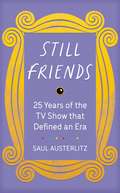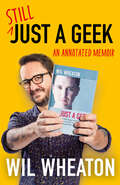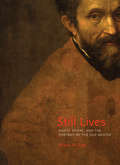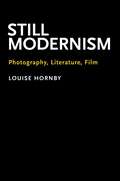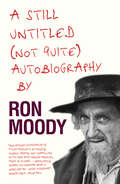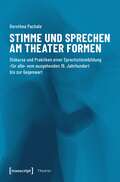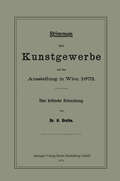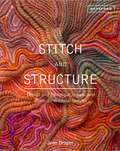- Table View
- List View
Still: American Silent Motion Picture Photography
by David S. ShieldsThe success of movies like The Artist and Hugo recreated the wonder and magic of silent film for modern audiences, many of whom might never have experienced a movie without sound. But while the American silent movie was one of the most significant popular art forms of the modern age, it is also one that is largely lost to us, as more than eighty percent of silent films have disappeared, the victims of age, disaster, and neglect. We now know about many of these cinematic masterpieces only from the collections of still portraits and production photographs that were originally created for publicity and reference. Capturing the beauty, horror, and moodiness of silent motion pictures, these images are remarkable pieces of art in their own right. In the first history of still camera work generated by the American silent motion picture industry, David S. Shields chronicles the evolution of silent film aesthetics, glamour, and publicity, and provides unparalleled insight into this influential body of popular imagery. Exploring the work of over sixty camera artists, Still recovers the stories of the photographers who descended on early Hollywood and the stars and starlets who sat for them between 1908 and 1928. Focusing on the most culturally influential types of photographs—the performer portrait and the scene still—Shields follows photographers such as Albert Witzel and W. F. Seely as they devised the poses that newspapers and magazines would bring to Americans, who mimicked the sultry stares and dangerous glances of silent stars. He uncovers scene shots of unprecedented splendor—visions that would ignite the popular imagination. And he details how still photographs changed the film industry, whose growing preoccupation with artistry in imagery caused directors and stars to hire celebrated stage photographers and transformed cameramen into bankable names. Reproducing over one hundred and fifty of these gorgeous black-and-white photographs, Still brings to life an entire long-lost visual culture that a century later still has the power to enchant.
Still Friends: 25 Years of the TV Show That Defined an Era
by Saul AusterlitzTwenty-five years on from when it first aired, Still Friends is an entertaining, fascinating and deeply researched behind-the-scenes look at the success of the hit show, Friends, featuring exclusive interviews with the show's creators, cast members and industry insiders. In September 1994, six friends sat down in their favourite coffee shop and began bantering. A quarter of a century later, new fans are still finding their way into the lives of Rachel, Ross, Joey, Chandler, Monica and Phoebe, and thanks to a combination of talented creators, its intimate understanding of its youthful audience, and its reign during network television's last moment of dominance, Friends has become the most influential and beloved show of its era. Noted pop culture historian Saul Austerlitz is here to tell us how it happened. Utilizing exclusive interviews with creators David Crane and Marta Kauffman, executive producer Kevin Bright, director James Burrows, and many other producers, writers, and cast members, Still Friends tells the story of Friends' creation, its remarkable decade-long run, and its astonishing Netflix-fuelled afterlife. Readers will learn how the show was developed and cast, written and filmed. They'll be reminded of episodes like the one about the trivia contest, the prom video, and the London trip. And, of course, the saga of Ross and Rachel. They'll also discover surprising details: that Monica and Joey were the show's original romantic couple, how Danielle Steel probably saved Jennifer Aniston's career, and why Friends is still so popular today. On the 25th anniversary of this truly groundbreaking show, it's clear that Friends has a legacy that has endured beyond wildest expectations. And in this hilarious, informative, and entertaining book, readers will now understand why.
Still Image Compression on Parallel Computer Architectures (The Springer International Series in Engineering and Computer Science #475)
by Savitri BevinakoppaStill Image Compression on Parallel Computer Architectures investigates the application of parallel-processing techniques to digital image compression. Digital image compression is used to reduce the number of bits required to store an image in computer memory and/or transmit it over a communication link. Over the past decade advancements in technology have spawned many applications of digital imaging, such as photo videotex, desktop publishing, graphics arts, color facsimile, newspaper wire phototransmission and medical imaging. For many other contemporary applications, such as distributed multimedia systems, rapid transmission of images is necessary. Dollar cost as well as time cost of transmission and storage tend to be directly proportional to the volume of data. Therefore, application of digital image compression techniques becomes necessary to minimize costs. A number of digital image compression algorithms have been developed and standardized. With the success of these algorithms, research effort is now directed towards improving implementation techniques. The Joint Photographic Experts Group (JPEG) and Motion Photographic Experts Group(MPEG) are international organizations which have developed digital image compression standards. Hardware (VLSI chips) which implement the JPEG image compression algorithm are available. Such hardware is specific to image compression only and cannot be used for other image processing applications. A flexible means of implementing digital image compression algorithms is still required. An obvious method of processing different imaging applications on general purpose hardware platforms is to develop software implementations. JPEG uses an 8 × 8 block of image samples as the basic element for compression. These blocks are processed sequentially. There is always the possibility of having similar blocks in a given image. If similar blocks in an image are located, then repeated compression of these blocks is not necessary. By locating similar blocks in the image, the speed of compression can be increased and the size of the compressed image can be reduced. Based on this concept an enhancement to the JPEG algorithm is proposed, called Bock Comparator Technique (BCT). Still Image Compression on Parallel Computer Architectures is designed for advanced students and practitioners of computer science. This comprehensive reference provides a foundation for understanding digital image compression techniques and parallel computer architectures.
Still Just a Geek
by Wil WheatonCelebrated actor, personality, and all-around nerd Wil Wheaton updates his memoir of collected blog posts with all new material and annotations as he reexamines one of the most interesting lives in Hollywood and fandom!
Still Life: Ecologies of the Modern Imagination at the Art Museum
by Fernando Domínguez RubioHow do you keep the cracks in Starry Night from spreading? How do you prevent artworks made of hugs or candies from disappearing? How do you render a fading photograph eternal—or should you attempt it at all? These are some of the questions that conservators, curators, registrars, and exhibition designers dealing with contemporary art face on a daily basis. In Still Life, Fernando Domínguez Rubio delves into one of the most important museums of the world, the Museum of Modern Art (MoMA) in New York, to explore the day-to-day dilemmas that museum workers face when the immortal artworks that we see in the exhibition room reveal themselves to be slowly unfolding disasters. Still Life offers a fascinating and detailed ethnographic account of what it takes to prevent these disasters from happening. Going behind the scenes at MoMA, Domínguez Rubio provides a rare view of the vast technological apparatus—from climatic infrastructures and storage facilities, to conservation labs and machine rooms—and teams of workers—from conservators and engineers to guards and couriers—who fight to hold artworks still. As MoMA reopens after a massive expansion and rearranging of its space and collections, Still Life not only offers a much-needed account of the spaces, actors, and forms of labor traditionally left out of the main narratives of art, but it also offers a timely meditation on how far we, as a society, are willing to go to keep the things we value from disappearing into oblivion.
Still Life: Ecologies of the Modern Imagination at the Art Museum
by Fernando Domínguez RubioHow do you keep the cracks in Starry Night from spreading? How do you prevent artworks made of hugs or candies from disappearing? How do you render a fading photograph eternal—or should you attempt it at all? These are some of the questions that conservators, curators, registrars, and exhibition designers dealing with contemporary art face on a daily basis. In Still Life, Fernando Domínguez Rubio delves into one of the most important museums of the world, the Museum of Modern Art (MoMA) in New York, to explore the day-to-day dilemmas that museum workers face when the immortal artworks that we see in the exhibition room reveal themselves to be slowly unfolding disasters. Still Life offers a fascinating and detailed ethnographic account of what it takes to prevent these disasters from happening. Going behind the scenes at MoMA, Domínguez Rubio provides a rare view of the vast technological apparatus—from climatic infrastructures and storage facilities, to conservation labs and machine rooms—and teams of workers—from conservators and engineers to guards and couriers—who fight to hold artworks still. As MoMA reopens after a massive expansion and rearranging of its space and collections, Still Life not only offers a much-needed account of the spaces, actors, and forms of labor traditionally left out of the main narratives of art, but it also offers a timely meditation on how far we, as a society, are willing to go to keep the things we value from disappearing into oblivion.
Still Life: Ecologies of the Modern Imagination at the Art Museum
by Fernando Domínguez RubioHow do you keep the cracks in Starry Night from spreading? How do you prevent artworks made of hugs or candies from disappearing? How do you render a fading photograph eternal—or should you attempt it at all? These are some of the questions that conservators, curators, registrars, and exhibition designers dealing with contemporary art face on a daily basis. In Still Life, Fernando Domínguez Rubio delves into one of the most important museums of the world, the Museum of Modern Art (MoMA) in New York, to explore the day-to-day dilemmas that museum workers face when the immortal artworks that we see in the exhibition room reveal themselves to be slowly unfolding disasters. Still Life offers a fascinating and detailed ethnographic account of what it takes to prevent these disasters from happening. Going behind the scenes at MoMA, Domínguez Rubio provides a rare view of the vast technological apparatus—from climatic infrastructures and storage facilities, to conservation labs and machine rooms—and teams of workers—from conservators and engineers to guards and couriers—who fight to hold artworks still. As MoMA reopens after a massive expansion and rearranging of its space and collections, Still Life not only offers a much-needed account of the spaces, actors, and forms of labor traditionally left out of the main narratives of art, but it also offers a timely meditation on how far we, as a society, are willing to go to keep the things we value from disappearing into oblivion.
Still Life: Ecologies of the Modern Imagination at the Art Museum
by Fernando Domínguez RubioHow do you keep the cracks in Starry Night from spreading? How do you prevent artworks made of hugs or candies from disappearing? How do you render a fading photograph eternal—or should you attempt it at all? These are some of the questions that conservators, curators, registrars, and exhibition designers dealing with contemporary art face on a daily basis. In Still Life, Fernando Domínguez Rubio delves into one of the most important museums of the world, the Museum of Modern Art (MoMA) in New York, to explore the day-to-day dilemmas that museum workers face when the immortal artworks that we see in the exhibition room reveal themselves to be slowly unfolding disasters. Still Life offers a fascinating and detailed ethnographic account of what it takes to prevent these disasters from happening. Going behind the scenes at MoMA, Domínguez Rubio provides a rare view of the vast technological apparatus—from climatic infrastructures and storage facilities, to conservation labs and machine rooms—and teams of workers—from conservators and engineers to guards and couriers—who fight to hold artworks still. As MoMA reopens after a massive expansion and rearranging of its space and collections, Still Life not only offers a much-needed account of the spaces, actors, and forms of labor traditionally left out of the main narratives of art, but it also offers a timely meditation on how far we, as a society, are willing to go to keep the things we value from disappearing into oblivion.
Still Life: Ecologies of the Modern Imagination at the Art Museum
by Fernando Domínguez RubioHow do you keep the cracks in Starry Night from spreading? How do you prevent artworks made of hugs or candies from disappearing? How do you render a fading photograph eternal—or should you attempt it at all? These are some of the questions that conservators, curators, registrars, and exhibition designers dealing with contemporary art face on a daily basis. In Still Life, Fernando Domínguez Rubio delves into one of the most important museums of the world, the Museum of Modern Art (MoMA) in New York, to explore the day-to-day dilemmas that museum workers face when the immortal artworks that we see in the exhibition room reveal themselves to be slowly unfolding disasters. Still Life offers a fascinating and detailed ethnographic account of what it takes to prevent these disasters from happening. Going behind the scenes at MoMA, Domínguez Rubio provides a rare view of the vast technological apparatus—from climatic infrastructures and storage facilities, to conservation labs and machine rooms—and teams of workers—from conservators and engineers to guards and couriers—who fight to hold artworks still. As MoMA reopens after a massive expansion and rearranging of its space and collections, Still Life not only offers a much-needed account of the spaces, actors, and forms of labor traditionally left out of the main narratives of art, but it also offers a timely meditation on how far we, as a society, are willing to go to keep the things we value from disappearing into oblivion.
Still Life: Ecologies of the Modern Imagination at the Art Museum
by Fernando Domínguez RubioHow do you keep the cracks in Starry Night from spreading? How do you prevent artworks made of hugs or candies from disappearing? How do you render a fading photograph eternal—or should you attempt it at all? These are some of the questions that conservators, curators, registrars, and exhibition designers dealing with contemporary art face on a daily basis. In Still Life, Fernando Domínguez Rubio delves into one of the most important museums of the world, the Museum of Modern Art (MoMA) in New York, to explore the day-to-day dilemmas that museum workers face when the immortal artworks that we see in the exhibition room reveal themselves to be slowly unfolding disasters. Still Life offers a fascinating and detailed ethnographic account of what it takes to prevent these disasters from happening. Going behind the scenes at MoMA, Domínguez Rubio provides a rare view of the vast technological apparatus—from climatic infrastructures and storage facilities, to conservation labs and machine rooms—and teams of workers—from conservators and engineers to guards and couriers—who fight to hold artworks still. As MoMA reopens after a massive expansion and rearranging of its space and collections, Still Life not only offers a much-needed account of the spaces, actors, and forms of labor traditionally left out of the main narratives of art, but it also offers a timely meditation on how far we, as a society, are willing to go to keep the things we value from disappearing into oblivion.
Still Life
by Sarah WinmanTHE INSTANT SUNDAY TIMES BESTSELLER WINNER OF DYMOCKS BOOK OF THE YEAR A GUARDIAN BEST BOOK OF 2021 A BBC BETWEEN THE COVERS BOOK CLUB PICK WINNER OF THE INWORDS LITERARY AWARD ‘Sheer joy' Graham Norton ‘Utterly beautiful … filled with hope’ Joanna Cannon, author of Three Things About Elsie
Still Lives: Death, Desire, and the Portrait of the Old Master
by Maria H. LohMichelangelo was one of the biggest international art stars of his time, but being Michelangelo was no easy thing: he was stalked by fans, lauded and lambasted by critics, and depicted in unauthorized portraits. Still Lives traces the process by which artists such as Michelangelo, Dürer, and Titian became early modern celebrities.Artists had been subjects of biographies since antiquity, but Renaissance artists were the first whose faces were sometimes as recognizable as their art. Maria Loh shows how this transformation was aided by the rapid expansion of portraiture and self-portraiture as independent genres in painting and sculpture. She examines the challenges confronting artists in this new image economy: What did it mean to be an image maker haunted by one's own image? How did these changes affect the everyday realities of artists and their workshops? And how did images of artists contribute to the way they envisioned themselves as figures in a history that would outlive them?Richly illustrated, Still Lives is an original exploration of the invention of the artist portrait and a new form of secular stardom.
Still Looking: Essays on American Art
by John UpdikeIn Still Looking, John Updike has collected together his thoughts and observations on American art to produce an eye-opening follow-up to his 1989 art criticism classic Just Looking. Beginning with early American portraits and landscapes, he goes on to extol two late-nineteenth-century masters, Winslow Homer and Thomas Eakins, considers the eccentric pre-modern painter and graphic artist James McNeill Whistler, discusses the competing American Impressionists and Realists of the early twentieth century - and concludes with appreciations of the art of Edward Hopper, Jackson Pollock and Andy Warhol. The resulting collection of essays is proof that Updike is still looking and seeing what only he can describe.'As a writer Updike can do anything he wants' Margaret Atwood'John Updike writes with a steady brilliance about the world out there' Guardian
Still Modernism: Photography, Literature, Film
by Louise HornbyStill Modernism offers a critique of the modernist imperative to embrace motion, speed, and mobility. In the context of the rise of kinetic technologies and the invention of motion pictures, it claims that stillness is nonetheless an essential tactic of modernist innovation. More specifically, the book looks at the ways in which photographic stillness emerges as a counterpoint to motion and to film, asserting its own clear visibility against the blur of kinesis. Photographic stillness becomes a means to resist the ephemerality of motion and to get at and articulate something real or essential by way of its fixed limits. Combining art history, film studies and literary studies, Louise Hornby reveals how photographers, filmmakers, and writers, even at their most kinetic, did not surrender attention to points of stillness. Rather, the still image, understood through photography, establishes itself as a mode of resistance and provides a formal response to various modernist efforts to see better, to attend more closely, and to remove the fetters of subjectivity and experience. Still Modernism brings together a series of canonical texts, films, and photographs, the selection of which reinforces the central claim that stillness does not lurk at the margins of modernism, but was constitutive of its very foundations. In a series of comparisons drawing from literary and visual objects, Hornby argues that still photography allows film to access its own diffuse images of motion; photography's duplicative form provides a serial structure for modernist efforts to represent the face; its iterative structure articulates the jerky rhythms of experimental narrative as perambulation; and its processes of development allow for the world to emerge independent of the human observer. Casting new light on the relationship between photography and film, Hornby situates the struggle between the still and the kinetic at the center of modernist culture.
Still No Idea (Oberon Modern Plays)
by Lisa Hammond Rachael Spence Lee SimpsonBest mates Lisa and Rachael are making a new show almost a decade after they created their first piece together.Back then they had no idea where to start so they went onto the streets and asked the public. What story should they tell? What characters should they play? When they saw Lisa in a wheelchair and Rachael not, what the public said was funny, jaw-dropping and ultimately heartbreaking. They made a show about it. It was called No Idea.Now people say the world has changed and things are looking up. There are more disabled people in the mainstream media, Lisa landed a big part on TV and disabled mates are getting regular auditions - happy days. So what kind of exciting stories are the TV professionals dreaming up for them?Still No Idea is the whole story (so far): the British public, the professional writers, the TV execs. Part verbatim theatre, part improv, part comedy sketch show, this is a raucous and mischievous exposé of good intentions gone bad and how sometimes no matter how hard we try, we still have absolutely no idea.
Still Open All Hours: The Story of a Classic Comedy
by Graham McCannFrom its first episode in 1973, Open All Hours was an instant hit. Audiences around Britain loved its familiar setting, good natured humour, and the hilarious partnership of Ronnie Barker and David Jason. Whilst it only ran for 26 episodes, it firmly cemented itself as a British comedy classic.To celebrate the 40th anniversary of the show in 2014, the BBC revived it for a one-off Christmas Special. Still Open All Hours was swamped by a tsunami of audience affection and the BBC promptly commissioned a full series. The first episode of the fifth series is expected to air in late 2014.With recollections from David Jason, his fellow cast members, and from the scriptwriter Roy Clarke, plus never before seen BBC archive material, acclaimed popular TV historian Graham McCann tells the inside story of this very British sitcom, with wit, insight and affection.
A Still Untitled (Not Quite) Autobiography
by Ron MoodyActor Ron Moody has enthralled generations with his masterly performance as Fagin in both the stage and film versions of Oliver! - one of the great classics of British theatre and cinema. Now, in this highly original, idiosyncratic and often very funny memoir, he looks back on those early days, describing in fascinating detail the twists and turns of his career, the people he met and worked with, and the many, varied roles that led up to Oliver! With characteristic frankness, he reveals the conflicts and clashes that can occur, both on and off stage, even in the most successful of shows. For this self-taught thespian every show has come with new lessons, and Moody weaves together these experiences to form his own theories on what ultimately makes a successful performance. Set on an academic career, Ron first took to the boards when a student at the London School of Economics - writing and acting in student revues. But such a comedic talent and the innate ability to create a string of eccentric and original characters quickly caught the attention of West End theatre producers, and the course of his life was changed forever.
Stilphasen der spätantiken Kunst: Ein Versuch (Arbeitsgemeinschaft für Forschung des Landes Nordrhein-Westfalen #44)
by Andreas RumpfStimme und Sprechen am Theater formen: Diskurse und Praktiken einer Sprechstimmbildung ›für alle‹ vom ausgehenden 19. Jahrhundert bis zur Gegenwart (Theater #114)
by Dorothea PachaleDorothea Pachale untersucht erstmals die Beziehung zwischen einer Sprechstimmbildung, die sich an eine breite Zielgruppe richtet, und den Praktiken des Theaters. Mit Fokus auf den deutschsprachigen Raum analysiert sie die auf die Stimme und das Sprechen ausgerichteten Techniken der Körperformung sowie die ökonomische und normative Ausrichtung einer Sprechstimmbildung ›für alle‹. Die kulturwissenschaftlich orientierte theaterwissenschaftliche Untersuchung, die sich an der Schnittstelle von theater- und sprechwissenschaftlichen sowie pädagogischen Fragestellungen bewegt, legt auch die Rolle der institutionellen Einbindung, die sich in den Verschiebungen und Überlagerungen von Disziplinar- und Performancegesellschaft zeigt, offen.
Stimmen über Kunstgewerbe auf der Ausstellung in Wien 1873: Eine Kritische Beleuchtung
by Hermann GrotheStitch: Sewing projects for the modern maker
by Jen RichStitch will offer contemporary designs and creative projects for the modern maker with a discernible eye for aesthetics, with a focus on customisable makes, stunning fabric inspiration, easy-to-follow instructions and beautifully graphic photography.The book will cover the basic techniques of sewing with all projects achievable either by using a sewing machine or by hand (and a little more time!), and with no overly complicated techniques. Each project will be photographed and some will be accompanied by step-by-step images to help guide you through more intricate instructions.With makes including reusable fabric bowl covers, pretty pot holders and scrunchies made from off cuts, as well as projects to up-cycle old bed linen or use up scraps of fabric left from other designs in the book, anyone from beginner to intermediate will find projects to love in this modern makers handbook.Explore modern sewing and learn to perfect your stitch.
Stitch 50 Birds: Easy sewing patterns for felt feathered friends (Stitch 50 #3)
by Alison J ReidFeather your nest with this avian collection of easy sewing patterns for beautiful bird designs, all made using simple hand-sewing techniques. Featuring the most popular and distinctive species – including garden birds, exotic birds, birds of prey, water birds, flightless birds and more – each pattern wings its way to you with step-by-step instructions and full-size templates, making them perfect for all abilities. The finished little birdies would make cute brooches, bag charms and home accessories, or can even be scaled up to make bigger plushes, all of which will make your friends into avid twitchers! Author Alison J Reid has spent months brooding away in her studio, researching all different kinds of birds, both common and rare. She has checked out their shapes, plumage and markings, and spent so much time trying to perfect their colourful, beautiful wings. It became an obsession! It was only by researching the various details that make each breed so distinctive, that Alison has been able to capture each of their unique qualities and differences. Pattern, colour and shape are key, so capturing these details in felt was important. Luckily, there are so many different colours of felt available! Felt's non-fraying, double sided, robust qualities make it easy to create all the little details that make each bird design so unique and instantly recognisable. Each bird pattern can be traced straight from the page (or enlarged if you want to sew a larger plush), and simple instructions mean that even beginners can get started. And because all the birds are sewn by hand, you don't need a sewing machine and can sit out in the garden with the birds while you sew. Whether you choose to sew just your own favourites, or make gifts for the other bird-lovers in your life, this book will provide hours of fun and inspiration.
Stitch 50 Cats: Easy sewing patterns for cute plush kitties (Stitch 50 #2)
by Alison J ReidBe the cat that got the cream with this feline collection of easy sewing patterns for the cutest cat designs, all made using simple hand-sewing techniques. Featuring the most popular and distinctive breeds – including long-haired, short-haired, hairless and even big cats –each pussycat pattern comes with step-by-step instructions and full-size templates, making them purrrfect for all abilities. The finished little kitties would make cute brooches, bag charms and home accessories, or can even be scaled up to make bigger plushes, all of which will make your cat-loving friends have kittens! Cats? But they're all the same, aren't they? Well, no not really! When you start to explore the many different breeds of cats, you realise just what a variety of breeds there is, and how different they are from each other. Author Alison J Reid has spent months beavering away in her studio, researching all different kinds of cats, both domestic and wild. She has checked out their colourings and markings, and spent so much time trying to perfect their colourful, beautiful eyes. It became an obsession! It was only by researching the various details that make each breed so distinctive, that Alison has been able to capture each of their unique qualities and differences. Pattern, colour and shape are key, so capturing these details in felt was important. Luckily, there are so many different colours of felt available, including fur-like mottled effects. Felt's non-fraying, double sided, robust qualities make it easy to create all the little details that make each cat breed so unique and instantly recognisable. She has also used small amounts of wool curls and roving to add texture for truly strokable results. Each cat pattern can be traced straight from the page (or enlarged if you want to sew a larger plush), and simple instructions mean that even beginners can get started. And because all the cats are sewn by hand, you don't need a sewing machine and can sit on the sofa with your cat while you sew. Whether you choose to sew just your own favourites, or make cats for the other crazy cat people in your life, this book will provide hours of fun and inspiration.
Stitch and Structure: Design and Technique in two- and three-dimensional textiles
by Jean DraperAn essential book for any textile artist looking to expand their repertoire into two- and three-dimensional work. Leading textile artist, teacher and examiner Jean Draper takes you through the entire process from designing through construction to embellishment with mixed media. This beautiful and very practical book includes diagrams, detailed drawings and stitch information to guide the reader through the techniques, which include hand and machine embroidery. It covers: Design, including recording information for translation into stitch (with lots of drawing tips); Choice of Threads, including some unusual threads and customizing them; Constructing with Thread, everything from knotted forms, with decorative threads, grids and stacks, and coiled structures; Stitches in Thin Air, constructing with stitch alone using moulds and soluble fabric; Using Mixed Media in Stitched Structures, such as paper, sticks, wire and plastics; Adding Structure to an Existing Fabric; Three-Dimensional Fabric Structures. Working in two and three-dimensions is a growing genre of textile art and this incorporates a fresh approach and great design advice.
Stitch Bible (PDF)
by K. HaxellIn this comprehensive guide to embroidery readers will learn the basic stitches and master 8 different embroidery styles, including blackwork, crewelwork, hardanger, pulled thread, goldwork and freestyle. Every stitch has clear step-by-step instructions and is accompanied by coloured diagrams. 17 beautiful projects will inspire readers to try out their new skills, with items ranging from bags and accessories to gifts and home decor.

